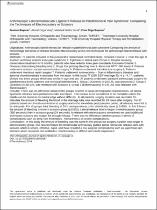Arthroscopic lateral retinacular ligament release in patellofemoral pain syndrome: Comparing the techniques of electrocautery or scissors

View/
Access
info:eu-repo/semantics/openAccessAttribution-NonCommercial-NoDerivs 3.0 Unported (CC BY-NC-ND 3.0)https://creativecommons.org/licenses/by-nc-nd/3.0/Date
2014Metadata
Show full item recordCitation
Başaran, T., Atay, A. O., Doral, M. N., Başaran, P. Ö. (2014). Arthroscopic lateral retinacular ligament release in patellofemoral pain syndrome: Comparing the techniques of electrocautery or scissors. Orthopaedic Journal of Sports Medicine, 2(11_suppl3).Abstract
Objectives: Arthroscopic lateral retinacular release in patellofemoral pain syndrome Comparing the amount of hemorrhage and times of release between electrocautery and a new techniques for arthroscopic lateral release with scissors Methods: 77 patients included in this prospective randomized controlled study. Inclusion Criteria: 1. Over the age of fourteen and have anterior knee pain syndrome 2. Tightness in lateral part of knee 3. Despite receiving conservative treatment for 6 months, patients who have anterior knee pain complaints Exclusion Criteria: 1. Diseases that prolong bleeding time 2. Drugs that prolong bleeding time 3. Abnormal APTT-INR levels 4. Patients underwent anterior cruciate reconstruction surgery 5. Patients underwent microfracture surgery 6. Patients underwent meniscus repair surgery 7. Patients underwent synovectomy -- Due to inflammatory diseases and synovial chondromatosis is excluded from the study. In this study 77 (25M 52W med age 50,14 ± 14,17) patients divided into three groups which was similar in age and sex. All patients underwent standard arthroscopic surgery for patellofemoral knee sydrome and meniscal debridement 1. Group 1 (Control) (n:10) LRL was preserved 2. Group 2 (Scissors) (n:33) LRL was released with Scissors 3. Group 3 (Electrocautery) (n:34) LRL was released with Electrocautery Results: There was no difference between the groups in terms of socio-demographic characteristics. All lateral ligaments releases were performed under tourniquet. The release is not considered to be complete unless the patella can be stood on its medial edge without difficulty. In all patients, surgery duration was recorded. To calculate the amount of bleeding the blood in the drainage tube was recorded for 24 hours after surgery. For 67 patients based on clinical examination at surgery and in the immediate postoperative period, all releases were felt to be adequate. For all groups total bleeding at 24 h postoperatively is the statistically same (p:0.850). In first 8 hours the amount of bleeding is more in scissors group (p:0.002). Lateral release time is longer in electrocautery group (380 seconds) than in scissors group (24 seconds). In release with electrocautery sometimes we used additional techniques scissors and scalpel for enough release. There was no difference between groups in terms of complications such as deep vein thrombosis, hemarthrosis or severe complications. Conclusion: In this study the amount of bleeding was the same in the groups but surgery duration was longer in electrocautery group. Our new technique for intraarticular arthroscopy guided lateral retinacular release uses with scissors which is simple, effective, rapid, and have resulted a few surgical complications such as superficial skin infection which responds oral antibiotics. Electrocautery is difficult and needs experience. © The Author(s) 2014.


















